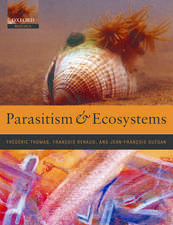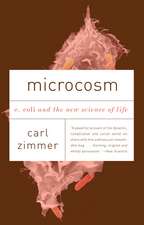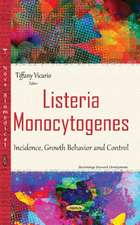Quorum Sensing vs Quorum Quenching: A Battle with No End in Sight
Editat de Vipin Chandra Kaliaen Limba Engleză Hardback – 9 oct 2014
| Toate formatele și edițiile | Preț | Express |
|---|---|---|
| Paperback (1) | 954.31 lei 6-8 săpt. | |
| Springer India – 23 aug 2016 | 954.31 lei 6-8 săpt. | |
| Hardback (1) | 961.86 lei 6-8 săpt. | |
| Springer India – 9 oct 2014 | 961.86 lei 6-8 săpt. |
Preț: 961.86 lei
Preț vechi: 1173.01 lei
-18% Nou
Puncte Express: 1443
Preț estimativ în valută:
184.08€ • 191.47$ • 151.96£
184.08€ • 191.47$ • 151.96£
Carte tipărită la comandă
Livrare economică 14-28 aprilie
Preluare comenzi: 021 569.72.76
Specificații
ISBN-13: 9788132219811
ISBN-10: 8132219813
Pagini: 404
Ilustrații: XI, 391 p. 94 illus., 42 illus. in color.
Dimensiuni: 178 x 254 x 27 mm
Greutate: 0.92 kg
Ediția:2015
Editura: Springer India
Colecția Springer
Locul publicării:New Delhi, India
ISBN-10: 8132219813
Pagini: 404
Ilustrații: XI, 391 p. 94 illus., 42 illus. in color.
Dimensiuni: 178 x 254 x 27 mm
Greutate: 0.92 kg
Ediția:2015
Editura: Springer India
Colecția Springer
Locul publicării:New Delhi, India
Public țintă
ResearchCuprins
1. Microbes: The Most Friendly beings?.- 2. Evolution of MDRs.- Quorum sensing mediated processes.- 3. Biofilms: Maintenance, Development and Disassembly of Bacterial Communities are determined by QS cascades.- 4. Quorum sensing in pathogenesis and virulence.- 5. Quorum sensing in Nitrogen fixation.- 6. Quorum sensing in competence and sporulation.- 7. How important is the absolute configuration to bacteria quorum sensing and quorum quenching.- Quorum sensing systems in microbes.- 8. Quorum sensing systems in Pseudomonas.- 9. Quorum sensing systems in Escherichia coli: Interkingdom, inter and intra species dialogues, and a suicide inducing peptide.- 10. Quorum sensing systems in Acinetobacter baumannii.- 11. Quorum sensing systems in Aeromonas spp.- 12. Rhizobial extracellular signaling molecules and their functions in symbiotic interactions with legumes.- 13. Quorum sensing systems in Clostridia.- 14. Quorum sensing systems in Enterococcus.- 15. Quorum sensing systems in Bacillus.- Detectors for Quorum sensing signals.- 16. Quorum sensing biosensors.- 17. Caenorhabditis elegans as an in vivo non-mammalian model system to study quorum sensing in pathogens.- 18. Strategies for silencing bacterial communication.- Natural quorum sensing inhibitors.- 19. Silencing bacterial communication through enzymatic quorum sensing inhibitors.- 20. Fungal quorum sensing inhibitors.- 21. Marine organisms as source of quorum sensing inhibitors.- 22. Plant quorum sensing inhibitors: Food, medicinal plants, others.- Synthetic quorum sensing inhibitors.- 23. Synthetic quorum sensing inhibitors: Signal analogues.- 24. Synthetic quorum sensing inhibitors blocking receptor signalling or signal molecule biosynthesis in Pseudomonas aeruginosa.- 25. Development of quorum sensing inhibitors targeting the fsr system of Enterococcus faecalis.- Alternative strategies as quorum sensing inhibitors.- 26. An alternative strategy as quorum sensing inhibitor: Pheromone-guided antimicrobial peptide.- 27. Alternative strategies to target quorum sensing (QS): Combination of QS inhibitors with antibiotics and nano technological approaches.- 28. Heterologous expression of quorum sensing inhibitory genes in diverse organisms.- Biotechnological applications of quorum sensing inhibitors.- 29. Potential applications of quorum sensing inhibitors in diverse fields.- 30. Biotechnological applications of quorum sensing inhibitors in aquacultures.- 31. The Battle: Quorum sensing inhibitors vs evolution of bacterial resistance.
Notă biografică
Dr. Vipin Chandra Kalia is presently working as Chief Scientist, Microbial Biotechnology and Genomics, CSIR- Institute of Genomics and Integrative Biology. He is a Professor, AcSIR who obtained his M.Sc. and Ph.D. Genetics, from Indian Agricultural Research Institute, New Delhi. He has been elected as: (i) Fellow of Association of Microbiologists of India (FAMI), and (ii) Fellow of National Academy of Sciences (FNASc). His main areas of Research are Microbial Biodiversity, Bioenergy, Biopolymers, Genomics and Microbial Evolution; Quorum sensing, Quorum quenching, Drug Discovery and Antimicrobials. He has published 65 papers in Scientific journals such as (i) Nature Biotechnology, (ii) Biotechnology Advances, (iii) Trends in Biotechnology, (iv) Critical Reviews in Microbiology, (v) Bio resource Technology, (vi) PLoS ONE, (vii) BMC Genomics. His works have been cited 1600 times with an h index: 22; i10 index: 35. He is presently the Editor in Chief of Indian Journal of Microbiology and Editor of (i) J Microbiol & Biotechnol(Korea), (ii). Appl. Biochem. & Biotechnology (USA), (iii) International Scholarly Res. Network Renewable Energy, (iv). Dataset Papers in Microbiol. Life member of Scientific Societies: (i) Society of Biological Chemists of India (ii) Society for Plant Biochem. & Biotechnol. (India); (iii) Association of Microbiologist of India; (iv) Indian Science Congress Association; (v) BioEnergy Society of India, (vi) Biotech Res. Soc. of India. (BRSI); Member: American Society of Microbiology. He can be contacted at: vckalia@igib.res.in; vc_kalia@yahoo.co.in
Textul de pe ultima copertă
Microbial relationships with all life forms can be as free living, symbiotic or pathogenic. Human beings harbor 10 times more microbial cells than their own. Bacteria are found on the skin surface, in the gut and other body parts. Bacteria causing diseases are the most worrisome. Most of the infectious diseases are caused by bacterial pathogens with an ability to form biofilm. Bacteria within the biofilm are up to 1000 times more resistant to antibiotics. This has taken a more serious turn with the evolution of multiple drug resistant bacteria. Health Departments are making efforts to reduce high mortality and morbidity in man caused by them. Bacterial Quorum sensing (QS), a cell density dependent phenomenon is responsible for a wide range of expressions such as pathogenesis, biofilm formation, competence, sporulation, nitrogen fixation, etc. Majority of these organisms that are important for medical, agriculture, aquaculture, water treatment and remediation, archaeological departments are: Aeromonas, Acinetobacter, Bacillus, Clostridia, Enterococcus, Pseudomonas, Vibrio and Yersinia spp. Biosensors and models have been developed to detect QS systems. Strategies for inhibiting QS system through natural and synthetic compounds have been presented here. The biotechnological applications of QS inhibitors (QSIs) in diverse areas have also been dealt with. Although QSIs do not affect growth and are less likely to impose selective pressure on bacteria, however, a few reports have raised doubts on the fate of QSIs. This book addresses a few questions. Will bacteria develop mechanisms to evade QSIs? Are we watching yet another defeat at the hands of bacteria? Or will we be acting intelligently and survive the onslaughts of this Never Ending battle?
Caracteristici
Defines quorum sensing (QS) systems as the global regulators of bacterial genes expression Discusses the potential of QS regulation as a new drug target for the treatment of bacterial infections Addresses to the increasing demand of antibiotic-resistant bacteria for novel strategies to control infectious diseases Includes supplementary material: sn.pub/extras










